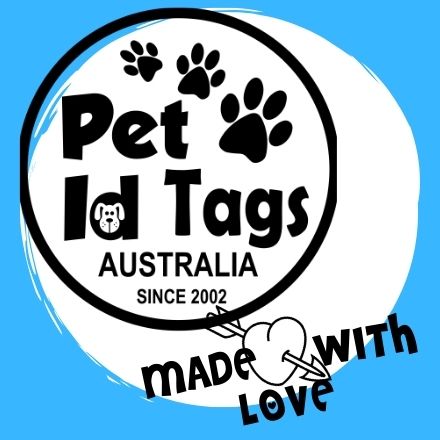Finding the perfect dog tag for your furry friend is about more than just style. It's about keeping them safe and secure. Whether you have a adventurous dog who loves to explore, a mischievous pup who likes to wander, or a senior canine who may need extra care, choosing the right dog tag is essential. This article will guide you through the process of selecting the perfect dog tag for your four-legged companion.
In this guide, we'll explore the different types of dog tags available and their unique features. From traditional engraved tags to QR code tags that provide instant access to your pet's medical information, we'll help you find the one that meets your needs. We'll also discuss important information to include on the tag, such as your pet's name and your contact details.
Your pet's safety is our top priority, and we want to make sure you have all the information you need to make an educated decision. So, let's dive in and find the perfect dog tag for your beloved canine companion.
The importance of dog tags for identification
Dog tags play a crucial role in identifying your beloved pet. In case they get lost or wander away from home, a well-designed dog tag can be their ticket back to safety. These small pieces of metal or plastic may seem insignificant, but they hold vital information that can make all the difference in reuniting you with your furry friend.
One of the main benefits of dog tags is that they provide instant identification. When someone finds a lost dog, the first thing they usually look for is a tag. This tag typically includes your pet's name and your contact information, such as your phone number or address. By having this information readily accessible, you increase the chances of a stranger contacting you and returning your beloved pet.
Not only do dog tags help with identification, but they also serve as a visible sign that your dog has an owner and is loved. This can deter potential thieves or individuals who may have harmful intentions towards your four-legged friend. Additionally, dog tags can indicate that your pet is up to date on vaccinations or has any specific medical conditions that need to be addressed.
Investing in a high-quality dog tag is a small price to pay for the peace of mind it brings. It ensures that your dog can be easily identified and returned to you in case of an emergency or accidental separation.
Different types of dog tags and their features
When it comes to dog tags, there are various options available, each with its own unique features. Let's explore some of the most popular types of dog tags and what sets them apart.
### Engraved Tags
Engraved dog tags are the most traditional and widely used type of dog tags. These tags are typically made of metal, such as stainless steel or aluminum, and have the necessary information engraved into the surface. Engraved tags are durable, resistant to wear and tear, and can withstand the elements.
One of the advantages of engraved tags is their simplicity. They are easy to read and provide a clear identification of your pet. You can include essential information, such as your pet's name, your phone number, and any medical conditions that require attention.
### QR Code Tags
In recent years, QR code tags have gained popularity due to their ability to provide instant access to your pet's medical information. These tags typically consist of a QR code printed on the surface, which can be scanned using a smartphone or a QR code reader. Once scanned, the code directs the scanner to a website or an online profile containing your pet's details.
QR code tags offer a convenient way to store additional information about your pet, such as their vaccination records, allergies, or any ongoing medical treatments. This can be especially useful in case of emergencies when immediate access to such information is crucial.
One thing to keep in mind with QR code tags is that not everyone may be familiar with how to scan a QR code. Therefore, it's essential to have a backup identification method, such as engraved information on the tag, to ensure your pet can be identified by anyone who finds them.
### GPS Tags
For pet owners who want to take identification to the next level, GPS dog tags are an excellent option. These high-tech tags utilize GPS technology to track your pet's location in real-time. This can be especially useful for dogs who tend to wander or have a knack for escaping.
GPS tags often come with a smartphone app that allows you to monitor your pet's location, set up geofences, and receive notifications if your pet goes beyond a predefined boundary. Some GPS tags even have additional features, such as activity tracking, temperature monitoring, and health alerts.
However, it's important to note that GPS dog tags require a subscription plan and rely on cellular networks for connectivity. While they offer advanced tracking capabilities, they may not be suitable for every pet owner due to the associated costs and potential limitations in certain areas with weak cellular coverage.
Engraving options for dog tags
When it comes to engraving your dog tag, there are a few options to consider. The most common method is traditional engraving, where the information is etched into the surface of the tag. This ensures durability and longevity, as the engraving is less likely to fade or wear off over time.
Another engraving option to consider is laser engraving. Laser engraving provides a more precise and detailed result compared to traditional engraving. It allows for intricate designs and additional customization options, such as adding graphics or logos to the tag.
When choosing an engraving method, it's crucial to ensure that the information is legible and easy to read. Opt for clear, bold fonts and ensure that there is enough contrast between the text and the tag's surface for maximum visibility.
Choosing the right material for your dog tag
The material of your dog tag is an important consideration, as it affects both the tag's durability and style. Here are some commonly used materials for dog tags:
### Stainless Steel
Stainless steel is a popular choice for dog tags due to its durability and resistance to rust and tarnish. It's a sturdy material that can withstand the wear and tear of everyday use, making it suitable for active dogs or those who spend a lot of time outdoors.
Stainless steel tags often have a polished or brushed finish, giving them a sleek and timeless look. They are also available in various shapes and sizes, allowing you to choose a tag that matches your pet's personality.
### Aluminum
Aluminum is another lightweight and durable material commonly used for dog tags. It is resistant to corrosion and can withstand exposure to water and harsh weather conditions. Aluminum tags are available in different colors and can be anodized for added protection and customization.
One of the advantages of aluminum tags is their affordability. They are generally more budget-friendly compared to stainless steel or other materials, making them a popular choice for pet owners looking for a cost-effective option.
Stylish and fashionable dog tags
Gone are the days when dog tags were simply functional and plain. Today, dog tags come in a wide range of styles, colors, and designs, allowing you to find one that reflects your pet's personality and your own sense of style.
For fashion-forward pet owners, there are dog tags adorned with crystals, rhinestones, or colorful enamel. These tags add a touch of glamour and can be a statement piece for your pet's collar. They are often available in various shapes, such as hearts, bones, or paw prints, adding a playful element to your pet's accessories.
In addition to decorative elements, some stylish dog tags offer customization options, such as adding your pet's photo or a personalized message. These tags not only look great but also provide a unique way to showcase your pet's individuality.
When choosing a stylish dog tag, it's important to ensure that it doesn't compromise the tag's functionality. Make sure the tag is still easy to read and that the information is clearly visible.
Personalizing your dog tag with unique designs
Personalizing your dog tag goes beyond simply adding your pet's name and your contact information. It's an opportunity to create a one-of-a-kind tag that stands out from the rest. Here are some unique design options to consider:
### Paw Print Design
A paw print design is a classic and timeless choice for dog tags. It symbolizes your pet's playful nature and serves as a reminder of the joy they bring into your life. Paw print designs can be incorporated into the tag's shape or engraved as a decorative element on the surface.
### Custom Graphics
If you want to take personalization to the next level, consider adding custom graphics to your dog tag. This can be your pet's breed, a favorite hobby, or a symbol that holds special meaning for you and your pet. Custom graphics can be laser engraved or printed onto the tag, depending on the material and design.
### Photo Tags
For pet owners who want to keep their furry friend's image close at all times, photo tags are a perfect choice. These tags allow you to add a small photograph of your pet to the tag's surface. It's a unique way to showcase your pet's adorable face and create a personalized tag that captures their essence.
When personalizing your dog tag with unique designs, it's important to strike a balance between aesthetics and functionality. Ensure that the design doesn't obstruct the legibility of the information and that the tag remains durable and resistant to wear and tear.
Ensuring the safety of your dog with reflective and glow-in-the-dark tags
Safety should always be a top priority when it comes to your pet. Reflective and glow-in-the-dark dog tags provide an extra layer of visibility, especially during low-light conditions. These tags help drivers, pedestrians, and other individuals spot your pet more easily, reducing the risk of accidents or incidents.
Reflective tags are designed with materials that reflect light, making them highly visible when exposed to headlights or other sources of light. They are often made with reflective tape or have a reflective coating, ensuring that your pet can be seen from a distance.
Glow-in-the-dark tags, on the other hand, contain phosphorescent materials that absorb light and emit a glow in the dark. These tags are especially useful during nighttime walks or if your pet tends to wander off in the evening. The glow ensures that your pet remains visible even in complete darkness.
When choosing reflective or glow-in-the-dark tags, consider the environment in which your pet spends most of their time. If you frequently walk your dog in urban areas with heavy traffic, reflective tags may be more suitable. If you live in a more rural or secluded area with limited artificial lighting, glow-in-the-dark tags may be a better option.
Tips for properly attaching and maintaining your dog's tag
Once you've chosen the perfect dog tag for your furry friend, it's important to ensure that it is securely attached to their collar and properly maintained. Here are some tips to help you keep your dog's tag in optimal condition:
### Use a Sturdy Attachment Method
Choose a reliable attachment method that will keep the tag securely fastened to your dog's collar. Split rings or S-hooks are commonly used for this purpose. They are durable and less likely to break or come loose compared to other attachment options, such as lobster clasps or plastic connectors.
Ensure that the attachment method is properly closed and that there is no gap where the tag could potentially slip off. Regularly check the attachment to make sure it hasn't loosened over time.
### Regularly Inspect the Tag
Inspect your dog's tag regularly to ensure that the information is still legible and that the tag itself is in good condition. Over time, the engraving may fade or become difficult to read, especially if the tag is exposed to harsh elements or excessive scratching.
If you notice any signs of wear or fading, consider replacing the tag to ensure that it remains effective in identifying your pet. Regular maintenance and inspection will help you catch any issues early on and prevent the tag from becoming illegible or falling off.
### Clean the Tag Regularly
To keep your dog's tag looking its best, clean it regularly. Depending on the material, you can use mild soap and water or a pet-safe cleaning solution to remove any dirt or grime. Avoid using harsh chemicals or abrasive materials that could damage the tag's surface or engraving.
After cleaning, make sure to thoroughly dry the tag before reattaching it to your dog's collar. Moisture trapped between the tag and the collar could lead to corrosion or damage over time.
Customizing your dog tag with additional information
While including your pet's name and your contact information is essential, there are other pieces of information you can consider adding to your dog tag. These additional details can provide helpful information to anyone who finds your pet and increase the chances of a safe return.
### Medical Information
If your pet has any specific medical conditions or requires medication, consider including this information on the tag. Allergies, chronic illnesses, or ongoing treatments can be crucial details that a veterinarian or a good Samaritan should know when caring for your pet.
Keep in mind that the available space on the tag may be limited, so choose the most important and relevant medical information to include. You can also consider using abbreviations or symbols to conserve space while still conveying the necessary information.
### Reward Offer
Offering a reward can be an additional incentive for someone to return your lost pet. Including a statement such as "Reward for Safe Return" or "Generous Reward Offered" on the tag can catch the attention of individuals who find your pet and motivate them to contact you.
When offering a reward, be sure to keep your contact information up to date and readily accessible. You want to make it as easy as possible for someone to reach out to you and claim the reward without any delays.
### Microchip Information
While microchipping your pet is a separate identification method, it's worth considering including a note on your dog's tag indicating that they are microchipped. This serves as a reminder to check for a microchip if someone finds your pet and may prompt them to take your pet to a vet or animal shelter for scanning.
Incorporating the universal microchip symbol (a small "M" inside a circle) on your dog's tag can also indicate that your pet has a microchip implant and help others recognize the significance of this identification method.
Conclusion: Finding the perfect dog tag for your furry friend
Selecting the perfect dog tag for your four-legged friend is an important decision that goes beyond style. It's about ensuring their safety and well-being. From engraved tags to QR code tags, there are various options available to suit your pet's needs and your personal preferences.
Consider the different features and materials available, and choose a tag that is durable, easy to read, and reflective of your pet's personality. Don't forget to include essential information like your pet's name and your contact details for easy identification.
Remember, your pet's safety is our top priority. By investing in a high-quality dog tag and properly maintaining it, you provide your beloved companion with the best chance of being quickly reunited with you in case of an accidental separation. So, take the time to choose the perfect dog tag and give yourself peace of mind knowing that



